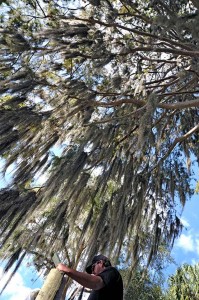Are we losing our iconic branding?

Spanish moss doesn’t just belong to the South because it thrives in humid climates and does not like prolonged temperatures below 25 degrees. It is symbolic of our culture because, like us, it’s enigmatic and “hard to figure.”
Because of my work, I know a fair number of biologists, botanists, naturalists. These users of multisyllabic and Latin words do not believe that Spanish moss is prettiest in central Florida. They think I’m “whacked.” That’s the polite term, but I don’t care. I know what I see, and scientists are not always attuned to the aesthetics. Besides, with pressing environmental issues in Florida like water nutrient levels, wildlife corridors, water supply arbitrations, sick springs, and Everglades restoration, I completely understand why pretty Spanish moss might not command their full attention.
That said, it is interesting that everyone else I ask always seems to admit something like “Come to think of it’ there is more of it there. Wonder why that is?”
In my right brained “wondering,” I’ve also been curious about how Spanish moss is supposed to be found in every county of the state but is fairly uncommon in South Florida. Was it always that way? You would think in the swampy cypress worlds of Corkscrew and Fakahatchee Strand (the Bromeliad Capital of the continent), there would be more Spanish moss than say, Lake Henderson in Inverness. But that is not the case. I’ve also noticed that in regions of the state where it is prevalent, it is sparse in urban neighborhoods and metropolitan areas. And then there are the folks in North Florida who swear its getting less and less prolific.

2011, Homosassa Springs. People are always talking about how spooky it is, but its haunting descriptions are foreign to me. Stuffed waterfall pillows, comfy cool bedding, dangling silk accessories and tree hair have crossed my mind, but never anything scary. If I were a fairy and free from the worry of ticks and chiggers, I would live in it. But as a mortal gazing upon a tree adorned in all its fineries, well, its aura just makes me sleepy. Maybe it’s the humidity and heavy air that sustains it, but then again, moss blowing in crisp winter air seems billowy and soothing to me, too. Nothing frightful, just comforting the way curtains flipping through an open window can suddenly calm you down.
I don’t want to sound like a freaky environmental alarmist here, but the “whacked artist” in me is getting this feeling that old timers in the future will sit around talking about Spanish moss the way my grandfather’s peers talked about storied mangroves with “root legs” taller and thicker than a man. I hope we are not the last generation to get to take Spanish moss for granted, but environmental changes may threaten its ability to remain prolific. All kinds of things are starting to shift in our tree canopies.
It seems that Spanish moss is susceptible to air pollution and scientists think that may be why it is disappearing in cities. It makes sense. Crackers knew long ago that the moss didn’t collect on chimneys or in trees shading barbeque pits. It doesn’t take to prolonged bouts of smoky air—which more than likely means it has air quality issues we haven’t even begun to consider. Its copious livelihood is also relative to the health of the hydrologic cycle, and if you keep up with the news, you know Florida’s long-term water supplies are in trouble. It’s also not as hardy as southerners would expect and in the 1970s suffered from something of a parasitic mold epidemic that made its recovery slow in some regions. It even has its enemies. It’s considered a pest by pecan growers and many an organic foodie is unaware of the pesticides used in pecan groves to eliminate the infamous streaming plants.
ABOUT TREE HAIR
 “Remove bats, lizards and snakes before microwaving”
“Remove bats, lizards and snakes before microwaving”
I know one family who loves to reminisce about the time they had to endure houseguests from hell. When the horrible people were leaving they wanted to take some Spanish moss home. The family encouraged them to pick all they wanted—conveniently forgetting to tell them about the need to microwave it to remove its itchy insects before they loaded it up in the backseat.
While Tillandsia usneoides is gorgeous and has been historically useful for everything from mattresses to furniture and car upholstery, it also breeds cesspools of the itchiest, most loathsome insects known to fair-skinned people. Trust me!
Spanish moss doesn’t just belong to the South because it thrives in humid climates and does not like prolonged temperatures below 25 degrees. It is symbolic of our culture because, like us, it’s enigmatic and “hard to figure.” It’s been described as both spooky (Deliverance) and genteel (Steel Magnolias). Besides the irony that something so sublime could cause so much irritation (I have relatives like that), Spanish moss is not Spanish. It’s not even a moss. The seed-producing plant was here long before the earliest Spanish Conquistadors, and mosses do not flower.
Closely related to pineapples, the indigenous people called the bromeliad “tree hair” which certainly seems more appropriate than “Spanish moss,” or what the Crackers call “Old Man’s Beard” or “Gray Beard.” In early summer, its gray-green tangles bloom with the tiniest of individual flowers made up of three greenish-yellow petals. Once the flowers have bloomed, tiny red capsules develop that eventually split open to release the seeds. I’ve heard that the blooms sometimes give off a light fragrance at night—but it could have been in a Faulkner novel.

The indigenous people some 3,000 years ago were using Spanish moss to make fire-tempered pottery and weaving its fibers into cloth and rope. In northeastern Florida, Timucua women even made skirts and clothing out of Spanish moss (LeMoyne art above). Every time I consider this thought I get itchy all over and can’t help but cross my legs. Spanish moss is famous for harboring ticks and red bugs—what southerners call “chiggers.” With my sensitive redheaded skin, just the idea of ticks and chiggers in my personals freaks me out. Jacques LeMoyne was a French artist who came to Florida in 1564 with the French explorer Rene de Laudonniere. Of course there were already artists here, but LeMoyne was the first non-native artist in the new world. He traveled through North Florida, charting the coastline and depicting the lives of the Timucua Indians. Funny that his version of the natives look fair-skinned and have European features.
It’s stronger than it looks. Native Americans would soak it until its moss-colored outer scales flaked off to reveal its curly black inner fibers. These fibers are remarkably durable and were employed to weave a coarse fabric used for bedding, floor mats, and horse blankets. The tough fibers were also twisted into cordage that was used as rope.
Today it is considered a commercial crop used for floral arrangements and craft projects. Although most of the dried moss in craft stores is from Mexico, Florida’s three major suppliers provide live Spanish moss to a wide cross-section of the nation’s florists.
Beyond seeding, the epiphyte also spreads itself far and wide by homesteading. It easily propagates after winds pull it into other trees by simply attaching itself to a new branch. Birds also relocate it around the canopy because its lacelike foliage serves as a silky and supple nesting material. Rather than simply using the foliage to insulate and soften their nests, songbirds like the Yellow-throated Warbler and Northern Parulas establish nests directly in clumps of Spanish moss. While the Seminole bat also likes to roost directly in the tousled tresses to conveniently feed on its bugs and spiders, snakes wander through its ribbons to eat the bats and the birds.
Despite the vermin it shelters, this seemingly crocheted “air plant” is not parasitic. It merely “hangs out” on its host drinking in the humidity and waiting for rain. And because it has no roots, its scaly outer coating is designed to absorb nutrients from dust and soil in the air, and from the detritus that collects in tree bark.
The tree canopy is a mineral-poor environment ,and there is a reason Spanish moss doesn’t favor pine trees the way it does with Live Oaks and Cypress. These host trees have high rates of foliar leaching—the process where rainwater removes plant nutrients from the surface of the leaves. They provide the moss with an abundant supply of calcium, magnesium, potassium, and phosphorus.

2012, Lake Henderson in Inverness. Crackers historically called water turtles “cooters.” Like the word “Cracker,” the use of the name has changed in modern times. That said…ahem…the City of Inverness annually hosts the “Great American Cooter Festival” and Danny was all about the T-shirts—“Got Cooter?” or, “Cooters are Better than Hooters.” I on the other hand, was thrilled with the prolific Spanish moss adorning all the trees around Lake Henderson. Throughout the festival I kept dropping to the ground to photograph the diverse spectacles. Festival participants politely walked around me while Danny pretended everything was perfectly normal. Here he is reading a hunting brochure while I focus in on what’s really important.
Maybe that is why I notice (and the scientists do not!) that the Spanish moss north of Lake Okeechobee is more hardy and abundant than in other areas further north and in the traditional South—say in Tallahassee or Jacksonville. The center of the state marks the headwaters of the Everglades and features the peninsula’s “Chain of Lakes.” There the region’s prolific hydrologic cycle could play a part in its success, but the lower levels of urban pollution may also come into play. The subtropical climate of south Florida may yield greater pressure from plant pests and diseases being active all year, and so it could also be that Spanish moss appreciates a good cold spell and freeze now and then.
Although Spanish moss doesn’t live off the tree, it can hurt it. It retains much more than its weight in water, and in this sense it can weigh down its host tree and break branches. It can also inconvenience growth by shading-out the photosynthesis process in some sections of the tree.
I like to believe Cypress and Southern Live Oaks put up with the gothic jewelry because they know it makes them look elegant. But then again, in my whacked reality, it’s perfectly reasonable to believe trees also enjoy accessorizing and inevitably end up being slaves to fashion.

